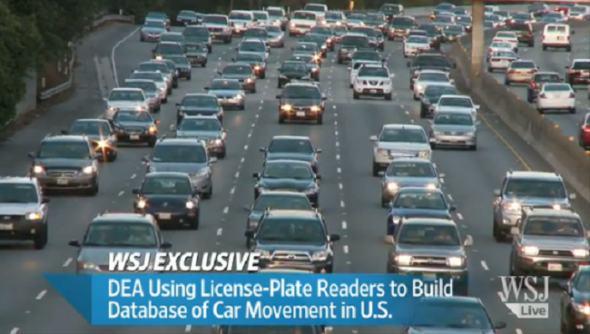U.S. Spies on Millions of Drivers
Daily News Article — Posted on January 30, 2015

(by Devlin Barrett, The Wall Street Journal) WASHINGTON – The Justice Department has been building a national database to track in real time the movement of vehicles around the U.S. — a secret domestic intelligence-gathering program that scans and stores hundreds of millions of records about motorists — according to current and former officials and government documents.
The primary goal of the license-plate tracking program, run by the Drug Enforcement Administration (DEA), is to seize cars, cash and other assets to combat drug trafficking (‘asset forfeiture’), according to one government document. But the database’s use has expanded to hunt for vehicles associated with numerous other potential crimes, from kidnappings to killings to rape suspects, say people familiar with the matter.
Officials have publicly said that they track vehicles near the border with Mexico to help fight drug cartels. What hasn’t been previously disclosed is that the DEA has spent years working to expand the database “throughout the United States,” according to one email reviewed by The Wall Street Journal.
Many state and local law-enforcement agencies are accessing the database for a variety of investigations, according to people familiar with the program, putting a wealth of information in the hands of local officials who can track vehicles in real time on major roadways.
The database raises new questions about privacy and the scope of government surveillance. The existence of the program and its expansion were described in interviews with current and former government officials, and in documents obtained by the American Civil Liberties Union (ACLU) through a Freedom of Information Act (FOIA) request and reviewed by The Wall Street Journal. It is unclear if any court oversees or approves the intelligence-gathering.
A spokesman for Justice Department, which includes the DEA, said the program complies with federal law. ”It is not new that the DEA uses the license-plate reader program to arrest criminals and stop the flow of drugs in areas of high trafficking intensity,” the spokesman said.
Sen. Patrick Leahy, senior Democrat on the Senate Judiciary Committee, said the government’s use of license-plate readers ”raises significant privacy concerns. The fact that this intrusive technology is potentially being used to expand the reach of the government’s asset-forfeiture efforts is of even greater concern.”
The senator called for “additional accountability” and said Americans shouldn’t have to fear “their locations and movements are constantly being tracked and stored in a massive government database.”
The DEA program collects data about vehicle movements, including time, direction and location, from high-tech cameras placed strategically on major highways. Many devices also record visual images of drivers and passengers, which are sometimes clear enough for investigators to confirm identities, according to DEA documents and people familiar with the program.
The documents show that the DEA also uses license-plate readers operated by state, local and federal law-enforcement agencies to feed into its own network and create a far-reaching, constantly updating database of electronic eyes scanning traffic on the roads to steer police toward suspects.
The law-enforcement scanners are different from those used to collect tolls.
By 2011, the DEA had about 100 cameras feeding into the database, the documents show. On Interstate 95 in New Jersey, license-plate readers feed data to the DEA—giving law-enforcement personnel around the country the ability to search for a suspect vehicle on one of the country’s busiest highways. One undated internal document shows the program also gathers data from license-plate readers in Florida and Georgia.
“Any database that collects detailed location information about Americans not suspected of crimes raises very serious privacy questions,” said Jay Stanley, a senior policy analyst at the ACLU. “It’s unconscionable that technology with such far-reaching potential would be deployed in such secrecy. People might disagree about exactly how we should use such powerful surveillance technologies, but it should be democratically decided, it shouldn’t be done in secret.”
License-plate readers are already used in the U.S. by companies to collect debts and repossess vehicles, and by local police departments to solve crimes.
In 2010, the DEA said in internal documents that the database aided in the seizure of 98 kilograms of cocaine, 8,336 kilograms of marijuana and the collection of $866,380. It also has been connected to the Amber Alert system, to help authorities find abducted children, according to people familiar with the program.
One email written in 2010 said the primary purpose of the program was asset forfeiture (a controversial practice in which law-enforcement agencies seize cars, cash and other valuables from suspected criminals). The practice is increasingly coming under attack because of instances when law-enforcement officers take such assets without evidence of a crime. …
The national vehicle database program was launched in 2008 and opened to participating state and local authorities a year later. The initial focus was on tracking cars moving on or near the Southwest border, in order to follow the movements of drugs and drug money, according to officials and documents. Requests to search the database are handled by the El Paso Intelligence Center in Texas, which is known as EPIC in law enforcement circles. EPIC is staffed around the clock to both take in and send out information about “hits” on requested license plates.
The effort began in border states like Arizona, California, Nevada, New Mexico and Texas, but the goal has always been expansion, according to current and former federal officials and documents. Officials wouldn’t say how many other states are now feeding data into the system, citing concerns that disclosing such information could help criminals avoid detection.
Copyright 2015 Dow Jones & Company, Inc. All Rights Reserved. Reprinted here for educational purposes only. May not be reproduced on other websites without permission from The Wall Street Journal. Visit the website at wsj .com.
